CONSUMER PRICE INDEX FOR ALL INCOME HOUSEHOLDS IN
SULTAN KUDARAT PROVINCE
NOVEMBER 2024
(2018=100)
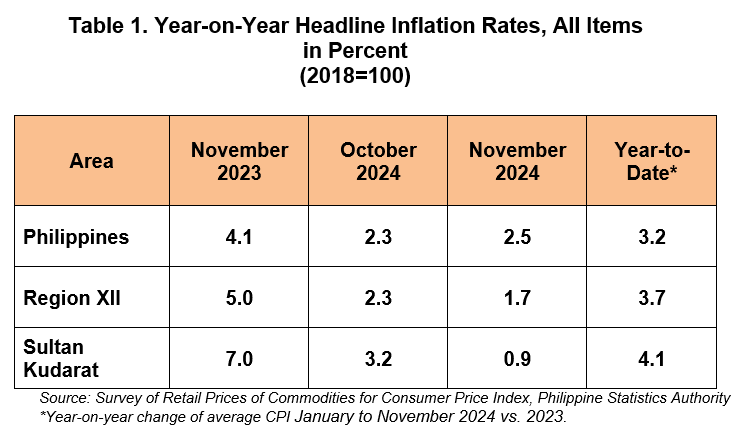
Inflation in Sultan Kudarat Province
1. Headline Inflation
The inflation rate or the year-on-year change on the prices of goods and services commonly purchased by people in the province of Sultan Kudarat slow down to 0.9 percent in November 2024 compared to 3.2 percent recorded in October 2024. This brings the provincial average inflation from January to November 2024 at 4.1 percent. (Table 1, Table 2 and Figure 1)
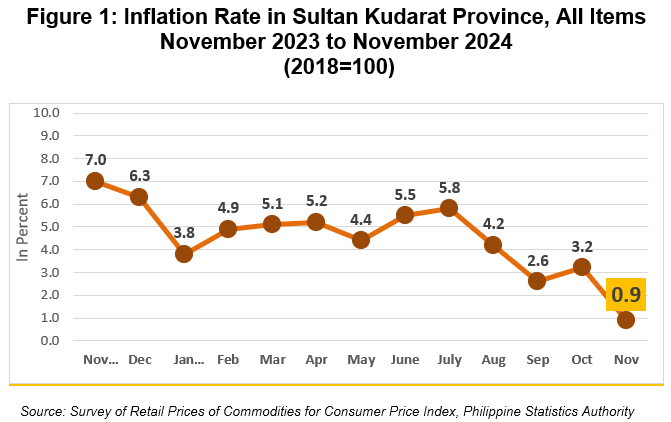
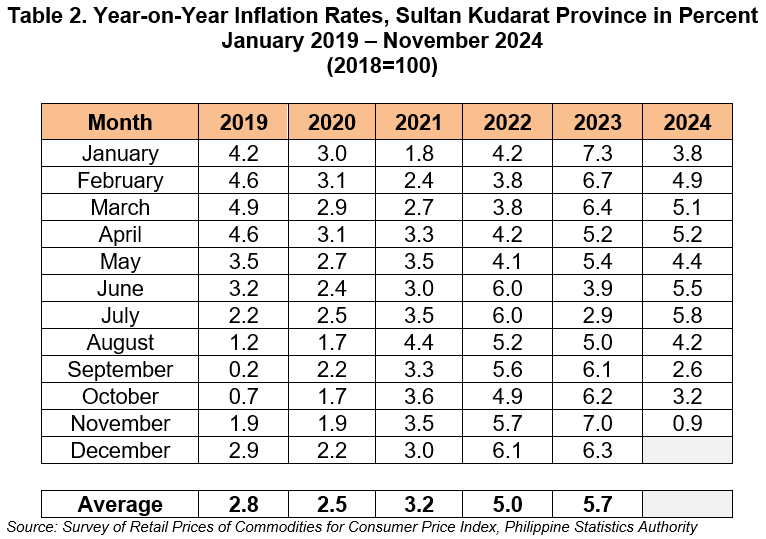
1.1. Main Drivers to the Downtrend of the Headline Inflation
The downtrend in the overall inflation in November 2024 was primarily influenced by the lower annual growth rate in the index of Food and Non-Alcoholic Beverages at 0.6 percent inflation compared to 4.4 percent in October 2024. This was followed by Housing, Water, Electricity, Gas and Other Fuels at 2.3 percent compared to 4.9 percent in October 2024, and Restaurants and Accommodation services at 2.5 percent from 3.8 percent in October 2024.
The following commodity groups also contributed to the downtrend of inflation during the month compared to October 2024 annual rates:
a. Clothing and Footwear at 0.5 percent from 0.7 percent;
b. Furnishings, Household Equipment and Routine Household Maintenance at 2.4 percent from 3.0 percent, and
c. Information and Communication at 0.2 percent from 0.4 percent.
In contrast, the four commodity groups registered higher inflation rates during the month.
a. Alcoholic Beverages and Tobacco at 1.3 percent from 0.8 percent;
b. Health at 1.3 percent from 1.2 percent;
d. Recreation, Sport and Culture at 3.1 percent from 3.0 percent, and
e. Personal Care, and Miscellaneous Goods and Services at 2.0 percent from 1.8 percent.
Transport continued to deflate during the month at -1.6 percent compared to its -2.0 percent deflation in October 2024.
Meanwhile the indices of the rest of the commodity groups retained their respective previous month’s inflation rate (Table 3)
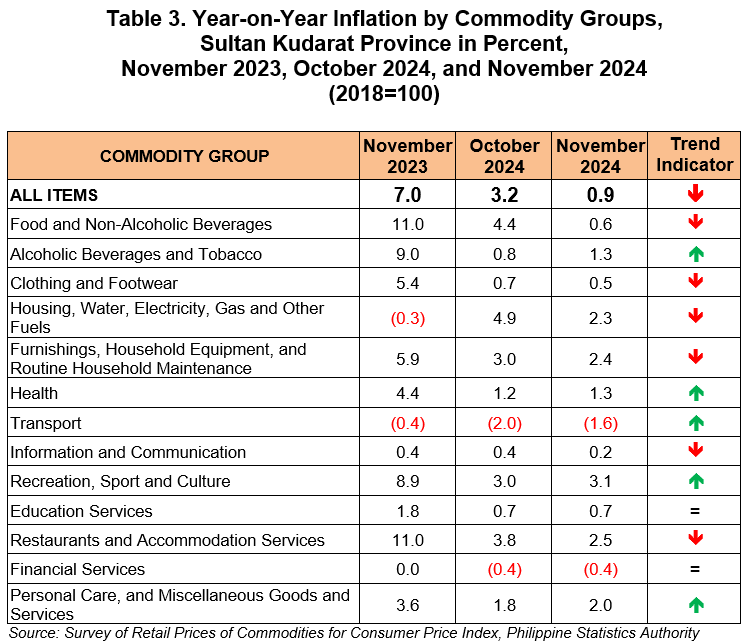
1.2 Main Contributors to the Headline Inflation
The top three commodity groups contributing to the November 2024 headline inflation were the following:
a. Housing, Water, Electricity, Gas and Other Fuels with 36.6 percent share;
b. Food and Non-Alcoholic Beverages with 30.5 percent share; and
c. Restaurants and Accommodation Services with 17.3 percent share.
2. Food Inflation
Food Inflation, likewise, slow down to 0.4 percent inflation compared to 4.5 percent reported in October 2024, in November 2023 food inflation was higher at 11.5 percent.
The following food groups also contributed to the downtrend of food inflation during the month:
a. Rice at -1.6 percent deflation compared to 14.3 percent;
b. Fish and other seafood at 1.6 percent compared to 2.4 percent;
c. Milk, other dairy products and eggs, at 2.2 percent compared to 3.7 percent; and
d. Fruits and Nuts at 2.8 percent compared to 12.4 percent.
In contrast, four food groups showed higher inflation during the month.
a. Meat and other parts of slaughtered land animals at 1.2 percent compared to 0.5 percent;
b. Oils and Fats at 12.9 percent compared to 9.1 percent;
c. Vegetables, tubers, plantains, cooking bananas, and pulses, at 1.0 percent compared to -10.6 percent deflation in October 2024; and
d. Ready-made food and other food products n.e.c at 4.1 percent compared to 3.4 percent.
Meanwhile, two food groups showed deflation during the month.
a. Rice at -1.6 percent deflation; and
b. Corn at -3.4 percent deflation.
Sugar, confectionery, and desserts retain its previous month rate at -8.7 percent deflation. (Table 4)
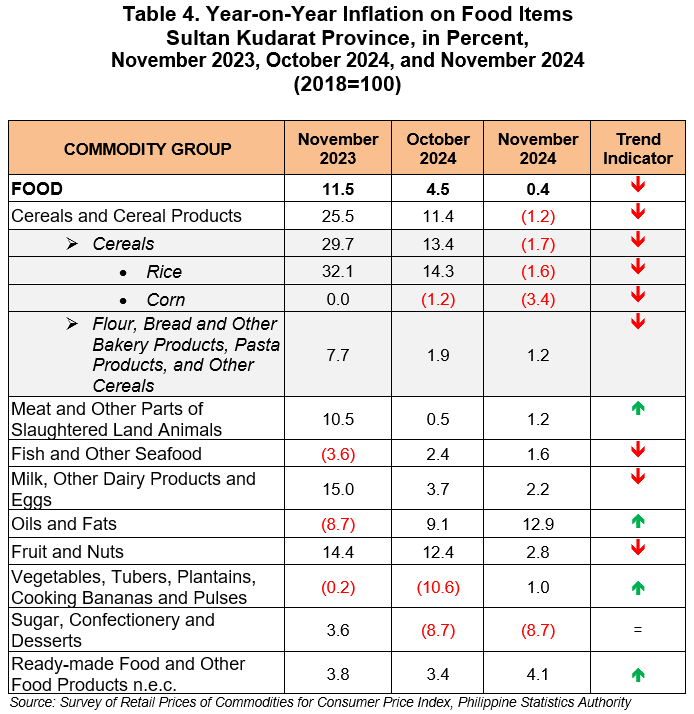
Main Contributors to the Food Inflation
The food groups with the highest contribution to food inflation during the month were the following:
a. Fish and other seafood with 84.2 percent;
b. Oils and Fats with 47.6 percent share; and
c. Meat and other parts of slaughtered land animals with 44.9 percent share.
Purchasing Power of Peso
The Purchasing Power of Peso (PPP) measures the current value of the peso in reference to its value in the base year. It has an inverse relationship with the Consumer Price Index (CPI), which means that if the CPI increases, the PPP decreases.
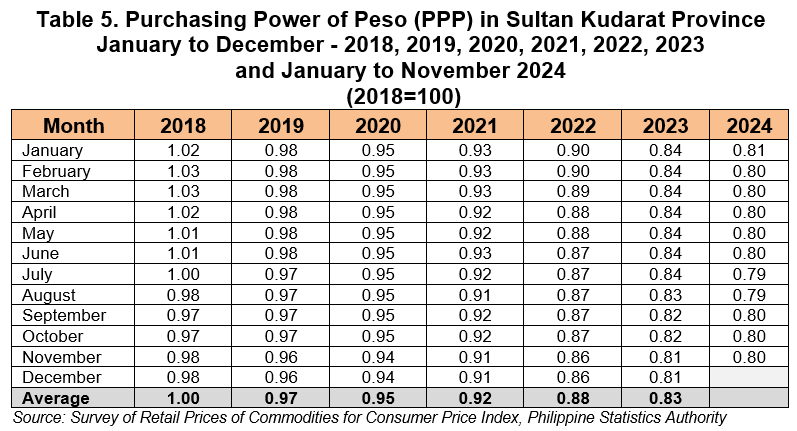
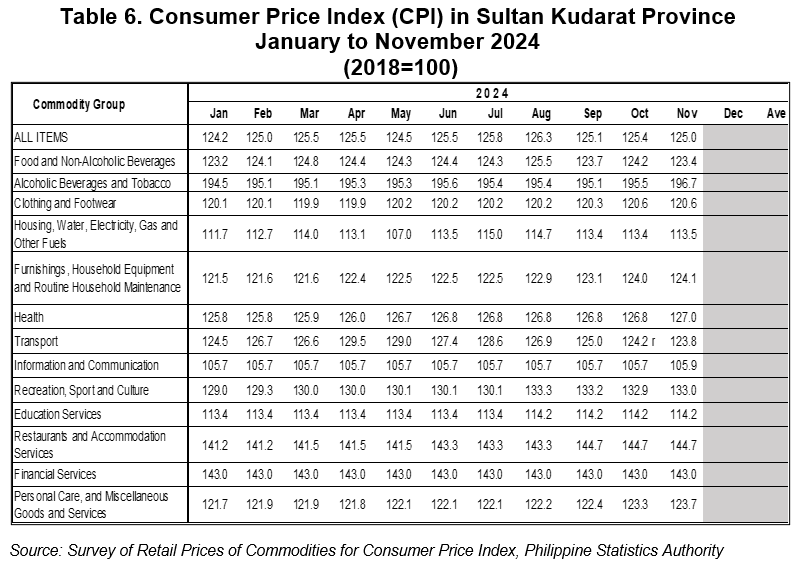
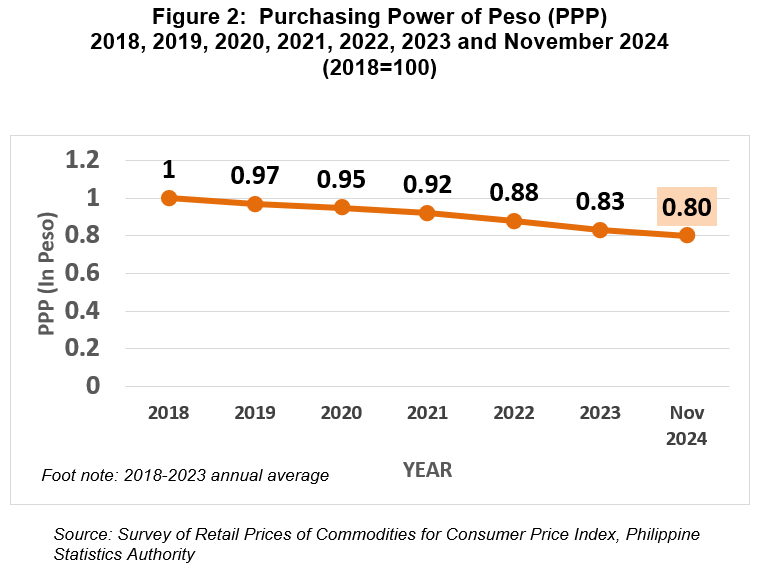

Table 5, Table 6 and Figure 2. showed that the PPP for the province of Sultan Kudarat dropped to PhP 0.80 in November 2024 from PhP 1.00 in 2018.
This means that the peso in 2018 is only worth 80 centavos in November 2024, or an average Sultan Kudarateños household need PhP 125.00 to purchase the same volume of goods and services worth P100.00 in 2018.
TECHNICAL NOTES
Consumer Price Index (CPI):
❖A measure of the change in the average retail prices of a fixed basket of goods and services commonly purchased by households relative to base year.
❖It measures the composite change in the consumer prices of various commodities overtime.
❖It stands for the percentage change in the average prices of goods and services commonly bought by a group of consumers from the base year.
Components of the CPI:
Market Basket
❖refers to sample of goods and services commonly purchased by a particular group of consumers in a particular area.
Weight
❖a value attached to a commodity or group of commodities to indicate the relative importance of that commodity or group of commodities in the market basket.
Base Period
❖a period usually a year, at which the index number is set to 100 or it is the reference point of the index number series.
Index Method
❖gives the formula used in computing the index number.
Sample Outlets
❖establishment or retail outlets where prices of commodities/services are collected or quoted.
Inflation Rate (IR)
❖rate of change in the average price level as measured by the CPI between two periods.
❖it is equivalent to the decline in the internal purchasing of the peso.
❖it is derived indicator by comparing the CPI between two periods, usually a year.
Approved for Release
MARIFI P. DE ASIS
(Supervising Statistical Specialist)
OIC- Chief Statistical Specialist
PSA-Sultan Kudarat Province

